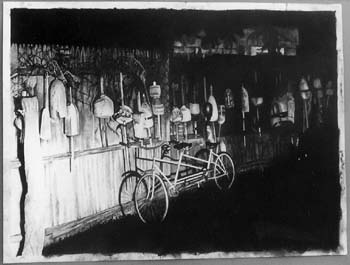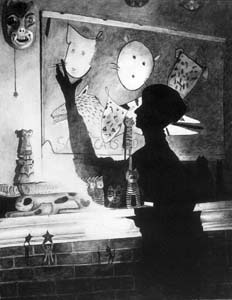![[MetroActive Arts]](/arts/gifs/art468.gif)
[ Arts Index | Santa Cruz Week | MetroActive Central | Archives ]
Texture Of the Past
With an outstanding two-person show at UC-Santa Cruz's Smith Gallery, artists Lynda Watson and Gaza Bowen travel unexpected avenues to collective memory
By Christina Waters
At first, the connections are difficult to find. How would anyone expect to see linkages between richly detailed charcoal drawings--the latest graphic output from Lynda Watson--and eccentric sculptures reclaimed from junk yards--the latest crafty expression from Gaza Bowen? Nonetheless the artistic slipstream is there, indelible as a watermark, making conceptual sense of the offerings at an exciting show opening at the Eloise Pickard Smith Gallery at UC-Santa Cruz's Cowell College.
Curated by Linda Pope, the show brings together two well-known Santa Cruz figures. Watson, a long-time Cabrillo College instructor, has been renowned for her exquisite metal and jewel pieces. Bowen earned international acclaim as a conceptual shoe creatrix--many will recall her provocative Brillo pad backless pumps. But for several years, Watson has drawn her memoirs as charcoal confessions. Similarly, Bowen's current fascination with the beauty of decay--rusted gutters, corroded pipes and chains, distressed metal of all kinds form her menagerie of materials--has evolved from her own highly personal artwork.
"The impetus for my artwork is still the same," says Watson, walking to her studio through a backyard ruled by enormous grey cats. "It still documents my life--it's still autobiographical."
A stack of small graphite drawings, skillfully observed "snapshots" from last year's travels through Portugal and Greece, rests in a corner. Enormous charcoal drawings--all of them nightscapes--line a far wall. The texture of the rich, creamy blacks is as thick as velvet. "I rub them with my hands to get that deep black," she smiles. "I love using my hands--it's a terrific mess."
Street scenes, backyards, alleys--all lit by a single light source--imply melancholy, as if waiting for someone or something that has long ago failed to show up. David Lynch meets Edward Hopper. Stark and dramatic, they soothe the eye, which quickly becomes accustomed to the intense black of Watson's shadows.
"I love the way lights at night transform simple things, creating unusual, unexpected shapes," she says. The deep black tones are developed over a long process of charcoal application and rubbing, more charcoal, more rubbing.
"They're about ruin and renewal. I loved how old buildings and places seemed to fall apart and yet people still lived in them, and found usefulness in them." Watson candidly talks of how she turned to this work after her divorce, a milestone in her life that powered some of the most powerful pieces. In one piece--a kind of wistful Vermeer--we see an empty bed through a narrow doorway.
In another, One Cup, Watson's lone tea cup sits in front of a roaring fire. A robe has been thrown over a single chair in another dramatic piece. "I call this series, 'Lies, Lessons and Loneliness,'" she adds. There are no people depicted--as if the viewer must be the witness to these painful moments of transition. In Watson's hands, memory becomes a shrine capable of evoking the complex range of reactions to loss, and change.
DEEP IN THE countryside north of Santa Cruz, Gaza Bowen has amassed the plunder of junkyards, dump sites and recycling areas for the decayed wires, screens, bolts, rivets, buckles, saw blades, corrugated siding, TV trays, tackle boxes, lawn chairs, barbed wire, knobs, lenses, doors and gears she uses in her new work, "Bibliotecha Memoria II."
Completely constructed of cast-off metal, this is an utterly fascinating library of cultural memory. Bowen reads more than meets most eyes in the rich hardware of the used, the formerly owned, the thrown away. Her incredibly skilled fingers can weave barbed wire like tapestry thread, embroider soft lead with silver wire and fashion gadgets that have no names into strong and serviceable fasteners for a defiantly wordless library.
The current installation--a portion of the large show she recently opened to much acclaim at Couturier Gallery in Los Angeles--is as witty as it is somehow sad. Viewers are welcome to come and sit down at library tables--all fabulously surreal creations of rusted screens, bolts and brackets--and read from texts without words.
"Yet they contain the memory of where they've been and what has happened to them," she says, with an impish grin. Next to an inverted barbecue kettle turned floor lamp stands a 10-foot-high wall of faux volumes. All the scratches, rust and scraped paint form a gorgeous array of colors and textures.
"I really liked making the curved spines by running the metal through an old washing machine ringer," Bowen admits. Fascinated with how books often become wallpaper, mere backdrop, Bowen spent hours gauging the mood, the atmosphere at UCSC's McHenry Library. "I was stunned by all those corridors of seemingly unopened books," she mused.
"Books organize time in a certain way--one page leads to another," she says, turning huge rectangles of filigreed copper mesh. "I wanted to give people an opportunity to slow down and look at things." Bowen is willing to describe her project as "building library reading rooms out of trash," but the whole idea of rescuing the past from junkyards has never been more opulent or well-crafted.
A large book, covered with gears that interlock and actually turn, offers six pages embedded with lenses. Through each lens, the next "page" is glimpsed, creating something like a hypertext of iron oxide.
She's dragged home siding from swimming pools, garden sheds and neighbors' gutters. These are cut into huge rectangles, shaped and then riveted, hinged or otherwise connected into unforgettable objects. Beautiful objects. "Each object has a history--everything you see at the dump has a story," Bowen says.
Practically on a first-name basis with workers at the local county dump (with whom she has a special arrangement), Bowen will spend this summer on a Norcal grant at the San Francisco city "dump" as artist-in-residence. The very idea delights her.
But it's the melancholy of old, worn-out objects that moves her. Bowen's installation, which will simultaneously show in McHenry Library's Special Collections, involves an encyclopedia of memory, without letters, yet mysteriously eloquent.
"Everything has to be built strong, yet I didn't want it too polished," she says, touching a particularly satisfying solution to a difficult hinging problem. Just figuring out how to attach things, rust to rust, metal to glass, is a clear source of pleasure for Bowen, whose technique is part Salvador Dali, part Sherlock Holmes.
The textural memories alone are astonishing. Squashed bottlecaps become a formal arrangement on a page of mesh. A huge slab of pipe forms the spine of a magnificently hinged "cover" of distressed aluminum. A rain gutter has been sliced and sewn, then punched with portholes through which the reds, oranges and browns of oxidation emerge vibrant. In the Smith Gallery installation, Bowen will architecturally alter the hallways and ceilings with her recycled magic, even turning the gallery courtyard into an enigmatic memorial filled with ruins and freeze frames of cultural history. Whose memories? Whose histories? Well, that's for us to read within her runic pages. Pages decipherable in countless ways, like miniature holographic worlds, where texture becomes text.
Copyright © Metro Publishing Inc. Maintained by Boulevards New Media.
![]()

The Haunting: For artist Lynda Watson's latest series, 'Lies, Lessons and Loneliness,'only viewers populate dark scenes remembered from European travels, as in 'Fence and Bike, Rock Harbor.'
 Sight Unseen: Artist Lynda Watson (as in 'You're the Best,' shown here) and sculptor Gaza Bowen both find beauty in ruin and decay.
Sight Unseen: Artist Lynda Watson (as in 'You're the Best,' shown here) and sculptor Gaza Bowen both find beauty in ruin and decay.
Bibliotecha Memoria II, constructions by Gaza Bowen, and Drawn From Observation, charcoal drawings on paper by Lynda Watson. On display at the Eloise Pickard Smith Gallery, Cowell College, UCSC, Feb. 13-March 12. Opening reception is Sunday (Feb. 13) 2-4pm. (459-2953)
From the February 9-16, 2000 issue of Metro Santa Cruz.